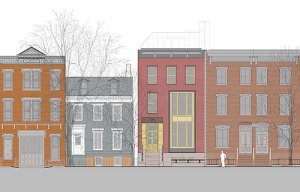 Who knew one small urban building could cause such controversy? On August 8, the Brooklyn Paper's Kate Briquelet wrote: "A city panel that had blocked a developer from building a true brownstone in the heart of brownstone Brooklyn now says that a red brick house is just fine. The Landmarks Preservation Commission unanimously approved architect Tom van den Bout’s new design for a Brooklyn Heights townhouse last Tuesday — two months after rejecting his original plan as a 'McMansion' that clashed with surrounding homes.
"The result will be a scaled-down and quirkier house on the long-vacant lot on 27 Cranberry St. rather than the architect’s novel plans to use actual brownstone imported from a century-plus-old quarry — a proposal that would have resulted in the first real 'Brooklyn brownstone' in decades. Van den Bout will use dark red brick rather than brownstone to harmonize with a wooden house next door, and zinc instead of bronze for window frames. Some community members appreciated the revisions, but said the building’s scale was still too grand." Full article here.
Who knew one small urban building could cause such controversy? On August 8, the Brooklyn Paper's Kate Briquelet wrote: "A city panel that had blocked a developer from building a true brownstone in the heart of brownstone Brooklyn now says that a red brick house is just fine. The Landmarks Preservation Commission unanimously approved architect Tom van den Bout’s new design for a Brooklyn Heights townhouse last Tuesday — two months after rejecting his original plan as a 'McMansion' that clashed with surrounding homes.
"The result will be a scaled-down and quirkier house on the long-vacant lot on 27 Cranberry St. rather than the architect’s novel plans to use actual brownstone imported from a century-plus-old quarry — a proposal that would have resulted in the first real 'Brooklyn brownstone' in decades. Van den Bout will use dark red brick rather than brownstone to harmonize with a wooden house next door, and zinc instead of bronze for window frames. Some community members appreciated the revisions, but said the building’s scale was still too grand." Full article here.
On August 10, the Brooklyn Daily Eagle's Linda Collins wrote: "The commission approved the revised design for the controversial building at 27 Cranberry St. in a 7-0 vote on Aug. 2, according to Lisi de Bourbon, press secretary for the LPC, who shared some of the 'very positive' comments from commissioners. Said Frederick Bland, 'It’s a very handsome house. What I particularly like now is that it owes nothing to anyone. It’s not a replica of anything, it’s also not a little of this a little of that — it’s its own thing. It’s an inventive contextual house in the best sense of that definition as far as I’m concerned.'
The four-story single-family rowhouse, a project of developer Lou Greco of SDS Development, will now have a brick façade and less bulk than the original design. Of the new design, van den Bout said it 'echoes rather than replicates' the traditional row houses that characterize the Brooklyn Heights Historic District. 'The house is composed of traditional elements — stoop, areaway, cornice, base, bay window, punched fenestration — in a traditional composition,' he said." Full article here.
Curbed and Brooklyn Heights Blog have also chimed in, and the comments are also worth reading.
